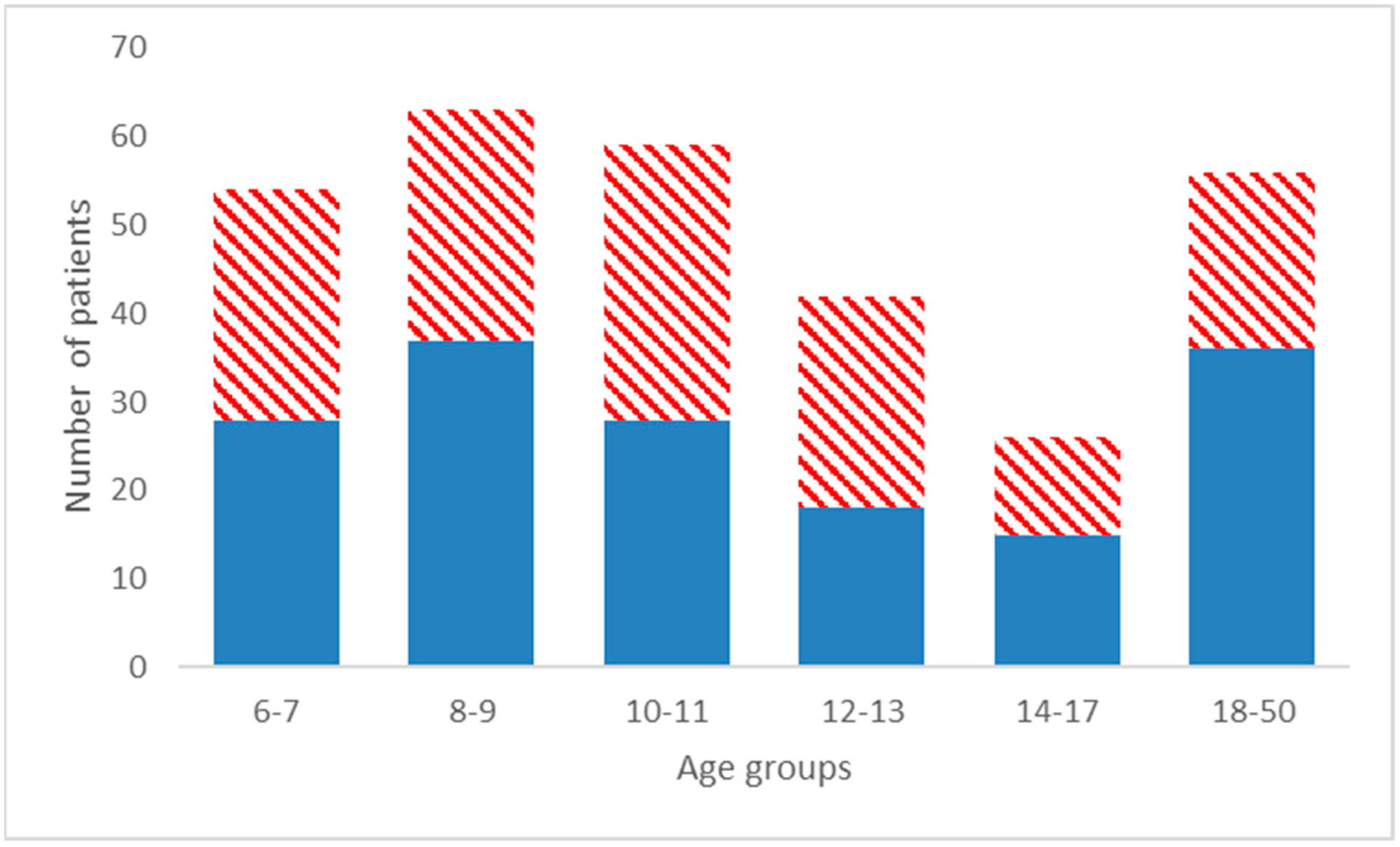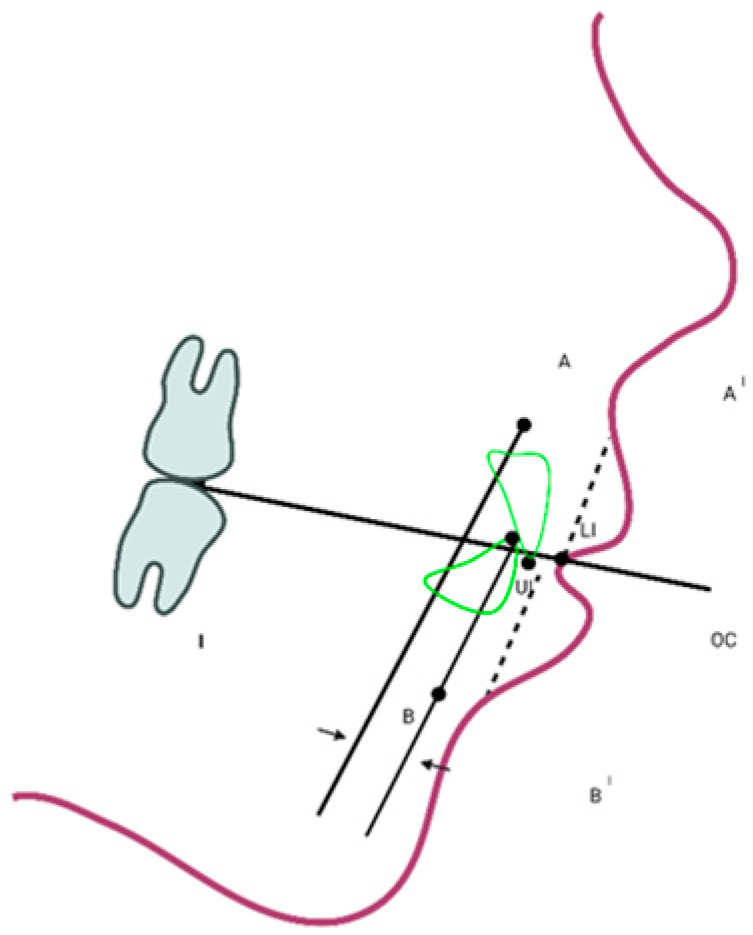The Maxilla-Mandibular Discrepancies through Soft-Tissue References: Reliability and Validation of the Anteroposterior Measurement
Abstract
1. Introduction
2. Materials and Methods
2.1. Sample
- Caucasian subjects with the same skeletal and dental patterns were selected in order to identify reliable landmarks and to subsequently extend to other ethnic groups;
- subjects with dental and skeletal malocclusions such as Class II or III, crowding, dental malpositions;
- mixed or permanent dentition;
- subjects who showed 3 mm of maximum difference between the right and the left Gonion and Maxillary points from the midsagittal plane in the frontal cephalometric analysis according to Hwang et al., 2007 [13];
- no cross-bite;
- no patients with surgical needs were evaluated.
- the absence of molars or premolars;
- past or current orthodontic therapies;
- bone metabolism modifications;
- the presence of asymmetry greater than 2 mm between the right and left homologous cephalometric landmarks;
- maxillofacial skeleton discrepancies (acquired or congenital).
2.2. Measurements
- Wits appraisal (obtained by projecting points A and B on the occlusal plane and subsequently measuring the distance between them, i.e., the plane drawn through the occlusal surfaces of the molar and the incisors), following the Hall-Scott procedure [15]
- Soft-tissue Wits appraisal (obtained by projecting points A’ and B’ on the occlusal plane and then measuring the distance between them (soft tissue A’: the most inner point on the profile of the upper lip between the Subnasale and the upper lip anterior point; soft tissue B’: the most inner point on the contour of the mandibular sulcus contour). See Figure 3.
2.3. Error of Method
3. Results
4. Discussion
5. Conclusions
Author Contributions
Funding
Institutional Review Board Statement
Informed Consent Statement
Data Availability Statement
Conflicts of Interest
References
- Oktay, H. A comparison of ANB, WITS, AF-BF, and APDI measurements. Am. J. Orthod. Dentofac. Orthop. 1991, 99, 122–128. [Google Scholar] [CrossRef] [PubMed]
- Moate, S.J.; Geenty, J.P.; Shen, G.; Darendeliler, M.A. A new craniofacial diagnostic technique: The Sydney diagnostic system. Am. J. Orthod. Dentofac. Orthop. 2007, 131, 334–342. [Google Scholar] [CrossRef] [PubMed]
- Yang, S.D.; Suhr, C.H. F-H to AB plane angle (FABA) for assessment of anteroposterior jaw relationships. Angle Orthod. 1995, 65, 223. [Google Scholar] [CrossRef]
- Hurmerinta, K.; Rahkamo, A.; Haavikko, K. Comparison between cephalometric classification methods for sagittal jaw relationships. Eur. J. Oral Sci. 1997, 105, 221–227. [Google Scholar] [CrossRef]
- Baldini, B.; Cavagnetto, D.; Baselli, G.; Sforza, C.; Tartaglia, G.M. Cephalometric measurements performed on CBCT and reconstructed lateral cephalograms: A cross-sectional study providing a quantitative approach of differences and bias. BMC Oral Health 2022, 22, 98. [Google Scholar] [CrossRef]
- Farronato, M.; Maspero, C.; Abate, A.; Grippaudo, C.; Connelly, S.T.; Tartaglia, G.M. 3D cephalometry on reduced FOV CBCT: Skeletal class assessment through AF-BF on Frankfurt plane—Validity and reliability through comparison with 2D measurements. Eur. Radiol. 2020, 30, 6295–6302. [Google Scholar] [CrossRef]
- Farronato, M.; Baselli, G.; Baldini, B.; Favia, G.; Tartaglia, G.M. 3D Cephalometric Normality Range: Auto Contractive Maps (ACM) Analysis in Selected Caucasian Skeletal Class I Age Groups. Bioengineering 2022, 9, 216. [Google Scholar] [CrossRef] [PubMed]
- Cenzato, N.; Iannotti, L.; Maspero, C. Open bite and atypical swallowing: Orthodontic treatment, speech therapy or both? A literature review. Eur. J. Paediatr. Dent. 2021, 22, 286–290. [Google Scholar] [CrossRef] [PubMed]
- Lee, M.; Kanavakis, G.; Miner, R.M. Newly defined landmarks for a three-dimensionally based cephalometric analysis: A retrospective cone-beam computed tomography scan review. Angle Orthod. 2015, 85, 3–10. [Google Scholar] [CrossRef]
- Zamora, N.; Cibrian, R.; Gandia, J.; Paredes, V. Study between anb angle and Wits appraisal in cone beam computed tomography (CBCT). Med. Oral Patol. Oral Y Cir. Bucal 2013, 18, e725–e732. [Google Scholar] [CrossRef]
- Kotuła, J.; Kuc, A.E.; Lis, J.; Kawala, B.; Sarul, M. New Sagittal and Vertical Cephalometric Analysis Methods: A Systematic Review. Diagnostics 2022, 12, 1723. [Google Scholar] [CrossRef] [PubMed]
- Hall-Scott, J. The maxillary-mandibular planes angle (MM°) bisector: A new reference plane for anteroposterior measurement of the dental bases. Am. J. Orthod. Dentofac. Orthop. 1994, 105, 583–591. [Google Scholar] [CrossRef]
- Sreenivasagan, S.; Sivakumar, A. FSA Angle: A Soft Tissue Approach for Assessing Sagittal Skeletal Discrepancy. Int. J. Clin. Pediatr. Dent. 2021, 14 (Suppl. S1), S54–S56. [Google Scholar] [CrossRef] [PubMed]
- McNamara, J.A. A method of cephalometric evaluation. Am. J. Orthod. 1984, 86, 449–469. [Google Scholar] [CrossRef] [PubMed]
- Ferrario, V.F.; Sforza, C.; Miani, A.; Tartaglia, G.M. The use of linear and angular measurements of maxillo-mandibular anteroposterior discrepancies. Clin. Orthod. Res. 1999, 2, 34–41. [Google Scholar] [CrossRef]
- Nanda, R.S.; Merrill, R.M. Cephalometric assessment of sagittal relationship between maxilla and mandible. Am. J. Orthod. Dentofac. Orthop. 1994, 105, 328–344. [Google Scholar] [CrossRef]
- Chang, H.-P. Assessment of anteroposterior jaw relationship. Am. J. Orthod. Dentofac. Orthop. 1987, 92, 117–122. [Google Scholar] [CrossRef] [PubMed]
- Kim, Y.H.; Vietas, J.J. Anteroposterior dysplasia indicator: An adjunct to cephalometric differential diagnosis. Am. J. Orthod. 1978, 73, 619–633. [Google Scholar] [CrossRef]
- Worms, F.W.; Isaacson, R.J.; Speidel, T.M. Surgical orthodontic treatment planning: Profile analysis and mandibular surgery. Angle Orthod. 1976, 46, 1–25. [Google Scholar] [PubMed]
- Ackerman, J.L.; Proffit, W.R.; Sarver, D.M. The emerging soft tissue paradigm in orthodontic diagnosis and treatment planning. Clin. Orthod. Res. 1999, 2, 49–52. [Google Scholar] [CrossRef]
- Kasai, K. Soft tissue adaptability to hard tissues in facial profiles. Am. J. Orthod. Dentofac. Orthop. 1998, 113, 674–684. [Google Scholar] [CrossRef]
- Hernández-Alfaro, F.; Vivas-Castillo, J.; de Oliveira, R.B.; Hass-Junior, O.; Hernando, M.G.; Valls-Ontañón, A. Barcelona line. A multicentre validation study of a facial projection reference in orthognathic surgery. Br. J. Oral Maxillofac. Surg. 2023, 61, 3–11. [Google Scholar] [CrossRef]
- Floyd, E.; Perkins, S. Anatomy of the facial profile. Facial Plast. Surg. 2019, 35, 423–429. [Google Scholar] [CrossRef]
- Reed, A. Holdaway. A soft-tissue cephalometric analysis and its use in orthodontic treatment planning. Part I. Am. J. Orthod. 1983, 84, 1–28. [Google Scholar]
- Budai, M.; Farkas, L.; Tompson, B. Relation between anthropometric and cephalometric measurements and proportions of the face of healthy young white adult men and women. J. Craniofac. Surg. 2003, 14, 154–163. [Google Scholar] [CrossRef] [PubMed]
- Almaqrami, B.-S.; Alhammadi, M.-S.; Cao, B. Three dimensional reliability analyses of currently used methods for assessment of sagittal jaw discrepancy. J. Clin. Exp. Dent. 2018, 10, e352–e360. [Google Scholar] [CrossRef] [PubMed]
- Tumedei, M.; Piattelli, A.; Falco, A.; De Angelis, F.; Lorusso, F.; Di Carmine, M.; Iezzi, G. An in vitro evaluation on polyurethane foam sheets of the insertion torque, removal torque values, and resonance frequency analysis (RFA) of a self-tapping threads and round apex implant. Cell. Polym. 2020, 40, 20–30. [Google Scholar] [CrossRef]
- Buccino, F.; Zagra, L.; Savadori, P.; Galluzzo, A.; Colombo, C.; Grossi, G.; Banfi, G.; Vergani, L.M. Mapping local mechanical properties of human healthy and osteoporotic femoral heads. Materialia 2021, 20, 101229. [Google Scholar] [CrossRef]
- Broadbent, B.H., Sr.; Broadbent, B.H., Jr.; Golden, W.H. Bolton Standards of Dentofacial Developmental Growth; CV Mosby Co.: Maryland Heights, MI, USA, 1975. [Google Scholar]
- Hwang, H.-S.; Youn, I.-S.; Lee, K.-H.; Lim, H.-J. Classification of facial asymmetry by cluster analysis. Am. J. Orthod. Dentofac. Orthop. 2007, 132, 279.e1–279.e6. [Google Scholar] [CrossRef] [PubMed]
- Ferrario, V.F.; Sforza, C.; Miani, A.; Tartaglia, G. Craniofacial morphometry by photographic evaluations. Am. J. Orthod. Dentofac. Orthop. 1993, 103, 327–337. [Google Scholar] [CrossRef]
- Masucci, C.; Franchi, L.; Franceschi, D.; Pierleoni, F.; Giuntini, V. Post-pubertal effects of the Alt-RAMEC/FM and RME/FM protocols for the early treatment of Class III malocclusion: A retrospective controlled study. Eur. J. Orthod. 2021, 44, 303–310. [Google Scholar] [CrossRef]
- Bittner, C.; Pancherz, H. Facial morphology and malocclusions. Am. J. Orthod. Dentofac. Orthop. 1990, 97, 308–315. [Google Scholar] [CrossRef]
- Ferrario, V.F.; Sforza, C.; Tartaglia, G.; Barbini, E.; Michielon, G. New Television Technique for Natural Head and Body Posture Analysis. Cranio® 1995, 13, 247–255. [Google Scholar] [CrossRef] [PubMed]
- Baik, C.Y.; Ververidou, M. A new approach of assessing sagittal discrepancies: The Beta angle. Am. J. Orthod. Dentofac. Orthop. 2004, 126, 100–105. [Google Scholar] [CrossRef] [PubMed]
- Sherman, S.L.; Woods, M.; Nanda, R.S.; Currier, G.F. The longitudinal effects of growth on the Wits appraisal. Am. J. Orthod. Dentofac. Orthop. 1988, 93, 429–436. [Google Scholar] [CrossRef] [PubMed]
- Bishara, S.E.; Fahl, J.A.; Peterson, L.C. Longitudinal changes in the ANB angle and Wits appraisal: Clinical implications. Am. J. Orthod. 1983, 84, 133–139. [Google Scholar] [CrossRef] [PubMed]
- Zamora, N.; Llamas, J.; Cibrian, R.; Gandia, J.; Paredes, V. A study on the reproducibility of cephalometric landmarks when undertaking a three-dimensional (3D) cephalometric analysis. Med. Oral Patol. Oral Y Cir. Bucal 2012, 17, e678–e688. [Google Scholar] [CrossRef]



| Age | Wits (mm) | Soft-Tissue Wits (mm) | Correlation Coefficient | ||||
|---|---|---|---|---|---|---|---|
| Group | Mean | SD | Range | Mean | SD | Range | X: Wits |
| (yrs) | Y: Soft-Tissue Wits | ||||||
| 6–7 | −0.61 | 3.92 | −9.8–7.1 | 2.40 | 3.88 | −6.9–9.7 | 0.876 |
| 8–9 | 0.61 | 2.83 | −5.7–6.8 | 3.90 | 3.11 | −7.5–10.3 | 0.752 |
| 10–11 | 0.52 | 2.79 | −5.8–6.6 | 4.54 | 3.40 | −3.7–11.0 | 0.786 |
| 12–13 | 0.22 | 3.14 | −6.6–5.4 | 3.63 | 3.67 | −5.7–10.6 | 0.796 |
| 14–17 | 0.90 | 3.49 | −6.2–9.7 | 4.76 | 3.37 | −3.5–11.5 | 0.719 |
| 18–50 | 0.09 | 5.20 | −18.8–11.5 | 4.49 | 5.23 | −9.8–14.9 | 0.880 |
| Total | 0.22 | 3.61 | −18.8–11.5 | 3.83 | 3.88 | −9.8–14.9 | 0.817 |
Disclaimer/Publisher’s Note: The statements, opinions and data contained in all publications are solely those of the individual author(s) and contributor(s) and not of MDPI and/or the editor(s). MDPI and/or the editor(s) disclaim responsibility for any injury to people or property resulting from any ideas, methods, instructions or products referred to in the content. |
© 2023 by the authors. Licensee MDPI, Basel, Switzerland. This article is an open access article distributed under the terms and conditions of the Creative Commons Attribution (CC BY) license (https://creativecommons.org/licenses/by/4.0/).
Share and Cite
Maspero, C.; Cenzato, N.; Inchingolo, F.; Cagetti, M.G.; Isola, G.; Sozzi, D.; Del Fabbro, M.; Tartaglia, G.M. The Maxilla-Mandibular Discrepancies through Soft-Tissue References: Reliability and Validation of the Anteroposterior Measurement. Children 2023, 10, 459. https://doi.org/10.3390/children10030459
Maspero C, Cenzato N, Inchingolo F, Cagetti MG, Isola G, Sozzi D, Del Fabbro M, Tartaglia GM. The Maxilla-Mandibular Discrepancies through Soft-Tissue References: Reliability and Validation of the Anteroposterior Measurement. Children. 2023; 10(3):459. https://doi.org/10.3390/children10030459
Chicago/Turabian StyleMaspero, Cinzia, Niccolò Cenzato, Francesco Inchingolo, Maria Grazia Cagetti, Gaetano Isola, Davide Sozzi, Massimo Del Fabbro, and Gianluca Martino Tartaglia. 2023. "The Maxilla-Mandibular Discrepancies through Soft-Tissue References: Reliability and Validation of the Anteroposterior Measurement" Children 10, no. 3: 459. https://doi.org/10.3390/children10030459
APA StyleMaspero, C., Cenzato, N., Inchingolo, F., Cagetti, M. G., Isola, G., Sozzi, D., Del Fabbro, M., & Tartaglia, G. M. (2023). The Maxilla-Mandibular Discrepancies through Soft-Tissue References: Reliability and Validation of the Anteroposterior Measurement. Children, 10(3), 459. https://doi.org/10.3390/children10030459













